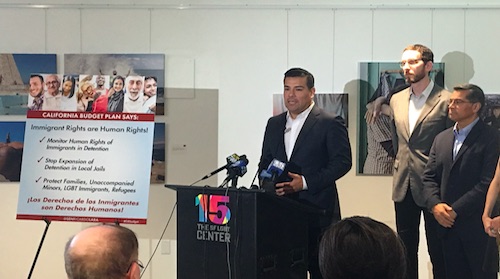Dark days continue for prospective immigrants to the U.S. Ahead of his visit to the US-Mexico border, President Joe Biden announced on Jan. 5 the expansion of Title 42, a Trump-era policy that allows the Department of Homeland Security to expel millions of migrants during the Covid-19 pandemic. The White House and the Department of Homeland Security announced their proposal to crack down on migrants who attempt to enter the country without required immigration papers. The proposal also allows 30,000 migrants from Cuba, Venezuela, Nicaragua, and Haiti to enter the country each month as part of a humanitarian parole program.
The status of DREAMERs also remains tenuous. While current DACA recipients can apply for renewals, a July 22 court ruling by Texas judge Andrew Hanen declares the program is illegal. Therefore, DHS is barred from accepting new applications.
Thousands of immigrants are stuck in decades-long queues to port their temporary business visas into permanent green cards. The backlog also affects their children. Will this year finally bring about the end of per-country caps, which limit each country to no more than 7 percent of available green cards each year?
Ethnic Media Services (EMS) examines these issues with speakers who will shed some light and counsel.
Kerri Talbot, Deputy Director for the Immigration Hub provided an overview of what to expect this year in immigration policy as well as the recent North American summit, talking a little bit first about Congress and actions the administration can and should take on immigration.
In terms of Congress, there was a push made last year to try to enact legislation that would have protected Dreamers as well as reform the border and asylum system. Unfortunately, that legislation did not move forward and so last year we did not see any fundamental changes to our immigration system. As everyone knows those changes are well overdue and we will keep pushing congress It will become much more difficult now because the House Republicans control Congress and making it difficult for any legislation to go through that would reach the president’s desk. The House Republicans do plan to push forward anti-immigrant legislation in the next couple of weeks in the house that we do oppose because they’re just inhumane policies pertaining to the border and those seeking asylum. We do not anticipate those will be able to pass in the Senate the Senate could possibly move forward with its own immigration legislation but it’s unlikely the house would pass whatever the Senate passes so unfortunately due to the Senate being under Democratic control and the House being under Republican control it’s not likely that they would be able to reach agreement but it’s important to continue to push forward as much as we can, to try to get Congress to enact sensible immigration policies where especially focus of the immigration hub on protecting dreamers, people with temporary protected status, and Farm Workers and allowing them at a minimum to be able to adjust status and stay in the United States permanently, and ideally we would cover the full 11 million individuals here who would like to become citizens in the US so I’ll note given the fact that Congress is unlikely to pass legislation ,the immigration hub will be focused on some of the issues that we will bring up with the administration and continue to push for our expansion of temporary protected status for individuals from countries that require it. For example, the administration just gave TPS for Somalia and we do hope and anticipate that they will do that for other countries as well so TPS is definitely an area where the administration has done a really good job extending protection to people who are not able to return to their home countries. In addition, we will talk to the administration about what they can do for DACA recipients, Knows here the Dream Act. DACA situation is up before the Supreme Court and will soon make its way to the Supreme Court, probably receiving a decision by 2025. So we are worried that DACA will or could likely eventually end and we would like the administration to protect DACA recipients to adjust their status and become green card holders. with long-term ties to the US to be able to access relief as well and we have ideas about how to better allow people to use non-immigrant visas as well as pass to relief more accessible. In addition, we will also focus on rejecting harmful policies as noted there was the North American summit that just happened and unfortunately, there were some not-so-good policies that came out In the days before the summit that were problematic and there were also some good policies among the North American leaders on increasing legal pathways to America and did expand parole policies so that individuals from certain countries can apply for parole into the United States. However, the Biden administration also expanded the use of title 42 which blocks Asylum seekers and they also said that they’re rolling out an asylum band that would ban individuals who transited through countries and possibly also people who enter between ports of entry. So those policies we did oppose and hope they will walk those back but it is really useful that President Biden was speaking to other leaders about enhancing legal pathways to the United States, that’s obviously one of our key objectives which are to allow more people to come here legally and finally, we’ll work with the agencies to try to improve processes and make sure human rights are protected, try to make sure we close detention centers that aren’t meeting basic standards, try to provide more legal counsel to people and proceedings and try to improve USCIS processes as well as reducing backlogs and also looking for ways either through Congress or through the administration to enhance access to Green cards.
Edward Kissam, Co-trustee at the Werner-Kohnstamm Family Fund, which actively defends immigrant rights.
Despite the terrible conditions faced by asylum seekers at the border I wanted to focus on the policy aspects of the whole title 42 and I’d like to start by calling your attention to the conceptually corrupt and scientifically inaccurate genesis of title 42 when it was first put in place by the Trump administration. There’s an excellent report by the House Subcommittee on the coronavirus crisis which includes some really relevant information specifically. The key information comes from Dr. Martin S. who was the director of CDC’s division of global migration quarantine. His testimony was, “that the proposed order was not drafted by me or my team, but was instead handed to us. In fact it was handed to CDC by Stephen Miller a well-known anti-immigrant figure for many years”. He went on in his testimony to the subcommittee to say that the facts about coronavirus at the border didn’t jive with the data and realities on the ground since there were already hot spots in the US that were much more already powerfully overwhelming. So the genesis was totally irresponsible. Subsequently, the anti-immigrant states sued to continue implementation of Title 42 at the point that the Biden Administration sought to terminate it. It was totally irresponsible in that if you look at their arguments they have entirely to do with complaints about the cost that states would incur serving immigrants and in dealing with the influx of immigrants. There is virtually nothing about public health in any of the plaintiff’s complaints in that litigation. It’s just simply generic arguments against immigrants. This is tragic because the actual bureau over Title 42 has distracted from the actual Public Health element to combat the covid pandemic. Public health experts agree that the key element in defending the country against the pandemic is increasing vaccination rates, a strategy that the same anti-immigrant elements are seeking to undermine with anti-vaxer statements. The Supreme Court’s decision consideration of the case is very interesting, particularly because of Justice Gorsuch’s very astute observation. He observes that the effort to use title 42 to deal with the border crisis is trying to use one tool for a public health crisis to solve another which is immigration at the border.
With that history where are we?
The new plans from the Biden Administration as detailed by secretary Mayorkas and by DHS; actually the availability of CBP1 for facilitating scheduling asylum seekers, and appointments at the border is a good one, however, whether it’s useful or not depends on how many interviews it can schedule, how those interviews are conducted, whether they include various consideration of the asylum seekers requests.
Another challenge is whether anything that the administration proposes at the border which includes a request for $ 3.4 billion to implement its proposed six pillars of the new strategy will pass Congress. There’s a horrifying Manifesto put forward by Chip Roy for commitment to secure the border framework by Texans for Texans which sets out his views along with 28 other House Republicans from Texa about what should be done and one of the things for example that Biden has proposed to do which is to provide adequate resources to migrant serving organizations is definitely on the hit list for the conservative Republicans.
In terms of provisions for the parole program obviously not so many of the Asylum Seekers who are supposed to benefit from that parole program are in a position to have US sponsors to actually secure financial support for them here $30,000 per month which may appear to be a generous offer is not really so much.
The second obvious is that they are not necessarily in a position to put those requests together, and one of the parts of the plan is already dead on arrival because of the Steven Miller-inspired notion of requiring Asylum Seekers from South America, Central America to seek asylum in Mexico has already been rejected by Mexico’s Ministry of Foreign Affair as quoted in a recent New York Times article. So what I would say is that the limited promise of the Biden new plan is uncertain but given the position that Republicans have taken I don’t have high hopes that it will be very effective.
Ariel G. Ruiz Soto, Policy Analyst, Migration Policy Institute spoke on DACA( Deferred Action For Childhood Arrivals).
The Deferred Action For Childhood Arrivals known as DACA is a program that is locked in place and it’s really protecting only a shrinking population since September 2017 following the decision of the Trump Administration to end the program. Since September 2017 the program has really been snared in litigation across district courts competing in Washington and other places trying to figure out what can be the future. The idea of how DACA was implemented by the Obama administration in 2012. Currently, those immigrants who had DACA prior to the termination date may apply to renew their status. After long series of appeals the Fifth Court, the first circuit court asked judge Hanon in Texas to evaluate the merits of the new administration’s issuance of guidelines which he did. A ruling could be delivered within weeks or months depending on the oral arguments that are scheduled by judge Hanon, who has suggested in previous texts that he delivered to the plaintiffs that he would like to move quickly on this issue and resolve the case significantly earlier or early this year.
For someone to have been eligible to receive DACA they have to enter the country before 2012, have been under the age of 16 when they came to the United States, have been under the age of 31 as of June 2012, have been in school with a high school diploma or equivalent, have been honorably discharged from the Armed forces and not have any criminal or felonies in their background. For those that have had DACA since 2012, research suggests that they have been given multiple benefits including new employment, accessing loans and banking options that they would not have otherwise been able to, and specifically in some states being able to purchase homes or cars, essentially loans and generally being able to contribute financially to their families and communities, professional certifications and also beneficiaries who have DACA can apply for advance parole which is a process that allows migrants to leave the country and to return or enter back to Ports of Entry legally. The current number of DACA holders is 590,000 in September 2022 and it shows that it’s fallen since its height in May of 2018 which was a little bit over 700,000. The reduction is due to several reasons including some DACA holders adjusting their status to another status either by marriage to a US citizen or by receiving a Visa or by other protection status and likely some DACA holders may have fallen out of status, may have committed a crime, or may have not reapplied in time, some may have left the country and perhaps some of them as well may have passed away. MPI estimates that today 1.2 million Immigrants would qualify for DACA as it stands and so the difference between the five hundred and ninety thousand to the 1.2 million here shows that there are some differences even before the program was ended. The program has had significantly high rates of application among Mexican immigrants and significantly lower rates among Asian immigrants but particularly among South Korean immigrants. In terms of demographics, the vast majority of DACA recipients are Mexicans with 81% of the population, smaller shares of immigrants with DACA are from Salvador 4% Guatemala 3%, and Honduras 2%. Of all the DACA holders, 54% identify as female and their average age is 20 years old. 29% of all DACA recipients live in California alone. These three states combined represent half of all DACA holders in the country. The top residents and metropolitan areas are in order: Los Angeles, New York City, Dallas, Houston, and Chicago. With all these findings it is possible to judge Hannon will rule against DACA as many have suggested and in that case absent any congressional election the program could sunset over the next two years. When that decision happens the Supreme Court may likely take this case if at least in the interim process the administration could also use discretionary enforcement agenda to reduce the prioritization of backup holders or former backup holders. In that case in terms of reducing their likelihood of being deported a scenario where slowly, and gradually those benefits and economic but also social benefits that they’ve received will be going away and many possibly some of them may consider going back to their country of origin.
Cyrus Mehta, Founder of Cyrus D. Mehta & Partners PLLC, which focuses on immigration law discusses business immigration.
I’m going to be focusing on legal immigration the employment-based and to some extent family-based system. These are pathways for foreign nationals to be sponsored for permanent residence, for green cards and then they can apply for US citizenship, for different categories of skilled workers, for investors, for religious, because this cap has never been increased since 1990 which was the last update to the employment and to some extent the family-based immigration system so clearly the legal immigration system needs an update.
Within this system employment-based system even though you have annual limits for different categories you have country caps per country limits. Each country can only get 7% of the visas that are related so let’s take for example the employment-based second preference which applies to job offers made to people with Advanced degrees, there are 40,000 every year. Within that 40,000, each country can only get 7% which is just under 3000. You have a country like India which is the highest sending country, it’s completely oversubscribed and these folks are not waiting outside to come in, they’re already in legal status, they are on an immigrant visa like an H1B which is the work visa, and they have employers who sponsor them for green cards, they’ve gone through the labor market tests, have got approved petitions and now they’re waiting in line but guess how long the line is for the in-born beneficiary of an employment-based petition? You can take a guess but it has been determined that it’s going to take about 90 years. 90 years for the employee to get a green card. Meanwhile, they remain stuck in the H1B visa so are tied to a specific employer, and are beholden to that employer to get extensions when they travel outside the United States. It’s less hassle for other countries like Iran and China who can get their visas in 2-3 years.
So what has Congress been doing? Several bills have been brought before congress to create an equal playing field for all applicants but unfortunately, none have succeeded in becoming law because of differences in the reconciliation process. Even in the family base, there are also long weights. The way to kind of update the system is to give more visas but we know that there’s polarization in the House and the Senate and it’s very difficult to get more visas. You can actually provide more visas in a different way by not counting family members, so if, you’re a single person and then you have a family of three or four you count everybody as one that will actually go along with and reducing the backlogs, a simple fix that Congress can do by not counting family members and that can result in the elimination of the backlogs, the carve-out can be done based on STEM graduates or Ph.D. holders there are lots of solutions but unfortunately Congress is stuck.
The solution lies in comprehensive immigration reform and to get there you need to get everybody involved both Houses of Congress have to pass comprehensive immigration reform which has been elusive for a very very long time. In the meanwhile there are lots of proposals for administrative actions for example, can beneficiaries of approved i-140 petitions be given work authorization? Yes of course they can be given and just like in DACA if you provide this kind of administrative reforms they could get challenged, there could be lawsuits and these lawsuits may not come from states like Texas but could come from US worker organizations and unions that may be opposed to foreign workers. The meeting here is, immigrants are not taking jobs from US workers we have the lowest unemployment rate ever in many decades and these folks are building in the backlogs they have been subject to a rigorous labor market test under the Immigration Act the employers have filed labor applications where they have placed advertisements first trying to recruit us workers and when you’re unsuccessful in finding a US worker only then can a labor certification be filed and approved and then you can get the Immigrant Visa petition approved but even after all that happens there is a line, and the line is huge and people are desperate because it’s not just the principal beneficiary that’s affected in the backlogs but also family members. If you’re a child and you turn over 21 and you are caught in the backlogs of your parents you won’t be able to even hope to get the green card with the parent, you’ll be left out and you’ll be finding your own way in this system and so it’s a pretty desperate system situation even for those who legally have complied with the law and it’s basically a mess and the entire immigration system is broken.









